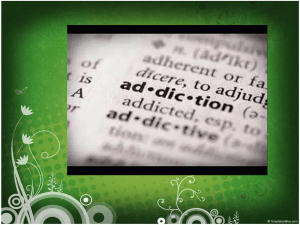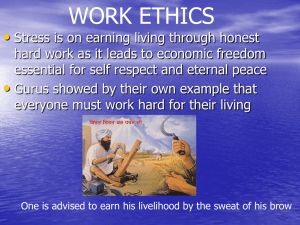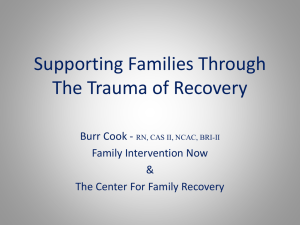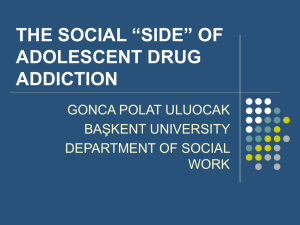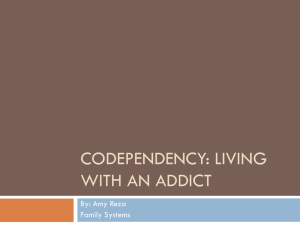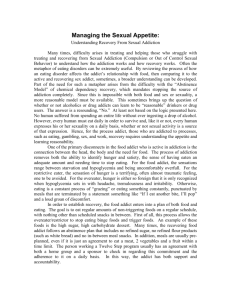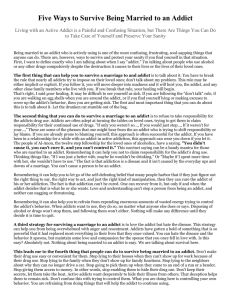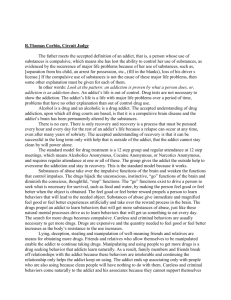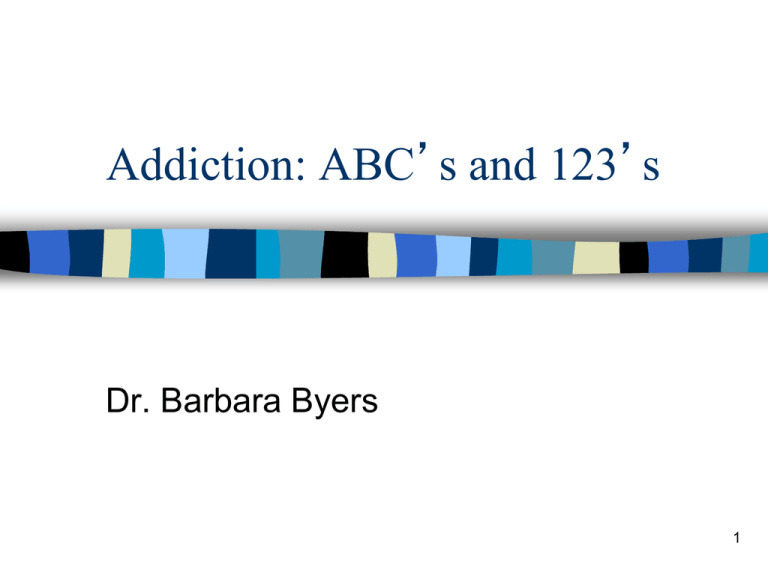
Addiction: ABC’s and 123’s
Dr. Barbara Byers
1
The ABC’s
A - The Addict and Addiction
B - Belief System
C - Cycle of Addiction
D - Decline Process
E - Enabling
F - Family Connection
2
A: What is Addiction?
It is not just frequent use of a substance or
process, but it is abuse coupled with:
–
–
–
–
–
–
deception,
loss in relationships,
dependency on the object,
loss of control,
attempts to stop bring withdrawal symptoms,
changes within the personality.
Why? To escape painful emotions and create
a different mood.
3
Addiction: 2 Types
1. Substance addictions
– Revolve around drinking, eating, ingesting,
inhaling, huffing, injecting, taking in
– Caffeine, nicotine, sugar, alcohol, drugs, painkillers
2. Process addictions: “doing”
– TV, shopping, internet, gambling, exercising,
stealing
– Relating: misery/victimization, hyper-religion, and
drama and chaos
4
Satiation and Arousal
Arousal
– Caffeine/tobacco, high risk behavior,
sexual behaviors, gambling, drugs
Satiation
– Alcohol, eating, drugs, sex, spending,
working
The addict wants to arouse but also
satisfy
5
The Addict:Risk Factors
“Addictive” personality features
Absence of good coping skills
Unmet emotional, social and spiritual
needs
Lack of support; broken family
Dysfunctional family messages
Unfinished business, pain of the past
6
B: Faulty Belief System
Addiction is an emotional relationship
with an object or process! We love and
trust it!
Addiction starts out as an emotional
illusion to cover deeper impaired beliefs
As emotional level of addiction is
established, the process develops its
own emotional logic
7
C: Cycle of Addiction
Cycle begins with negative emotions
Start to get preoccupied with a way to soothe
and alleviate the emotions
Use something that’s worked before
Sets in a ritual
– Just preparation and anticipation begins bring
arousal and to soothe
Last stage of cycle: feel shame, blame,
remorse, self-hatred, hopelessness
8
D: Process of Decline
Loss of Control - signs of increasing
use:
– 1. Tolerance increases
– 2. Begin to experience impairment
– 3. Habits are established and dependency
is growing (stronghold)
– 4. Deception is set in, deceiving others and
ourselves
– 5. Attachment deepens
9
Decline: Personality Changes
Stage 1: Internal Change
– Mental preoccupation
– Commitment to a negative lifestyle
Shame
Euphoric recall
Denial, minimization, rationalization,
avoidance
10
Decline: Personality Changes
Stage 2:
– Logic develops into a rigid, delusional belief system
– Brain impairment
Stage 2 Behaviors
– Betrays; lies; blames
– Withdraws
– Spiritual deadening
Stage 2 Deep Ritualization
– “Negative surrender”
11
Decline: Personality Changes
Stage 3 - Chronic
Addicts have built strong defense system and
delusions
Have developed tolerance, so must act out
more often and more dangerously
Confident in ability to manipulate others while
feeling lost, isolated, ashamed
Feels cut off emotionally and spiritually
except with their object
12
Decline
Reaction of others:
– “To have a relationship with a practicing addict is very
painful and emotionally dangerous.” (Nakken)
– Relationships suffer as others feel intense pain
– Others react to withdrawal by addict
• Either withdraw or try to control or both
– Feel manipulated, lied to, blamed, betrayed, neglected
– Trust is fractured
– “Crazy making” - keep trying to make sense out of it
13
The Trip Wire: Enabling
Trip Wire = “something that activates
something greater”
Enabling: about living in orbit of
someone else’s pain, chaos, sorrow,
darkness, chaos, addiction, need
Enabling is about my own need to stay
connected, to fix
14
Enabling: Impaired Behaviors
Start to participate in same impaired mental
processes as addict
Feel the loss of relationship, try to deny it but
become angry, despairing
Efforts to change relationship are ineffective
and can intensify the system
Family makes adjustments - so all kinds of
co-dependencies develop
Over-focus: “The Addict” becomes family
scapegoat
15
Enabling: Behaviors
Preoccupation with addict’s problems leads
to controlling behaviors
– Assume that the co-addict has power over the addict
Sacrifice part of own identity to stay in the
relationship
Enabler starts with core beliefs life
– Often carry a sense of abandonment
– Often carry an inflated sense of responsibility
May use blame to shield own feelings
16
The Family Connection
Predisposition to addiction if parents
addicted
– Toxic family may pollute our attitudes
Develop ways of coping
Measure of dysfunction is how willing
we are not to talk about it!
Believe illusion that if acting out stops,
pain stops
17
What Now?
Assess the stage of use or addiction.
Recognize and stop the enabling in the
system.
Break the silence to disable the system.
Get outside help and support.
18
Intervention
Intervention is intended to force the addict to
make some changes in behavior.
–
–
–
–
–
Creates a crisis.
“No more promises.” “No more tears.”
It is a call to action with a specific plan.
Not a threat. Must be caring but clear.
Helps them break through patterns of denial to
admit there is a problem.
– Remember you are asking them to give up their
very best friend.
– Takes courage to face their rage and our enabling.
19
Detachment
If you are an enabler, you have probably tried
all the wrong approaches.
– Feel frustrated, angry, abandoned, hopeless
Detachment is the key.
– Move out of their orbit as much as possible.
– Limit yourself; get help for YOU.
– Don’t cover for them; don’t keep their secret.
Not about not feeling emotions, about being
stable and not reacting.
20
Detachment
Idea is to separate yourself emotionally from
the damaging effects of your relationship with
the addict
– Not abandonment!
– Not complete dissociation.
Move away from taking too much
responsibility.
Move away from control.
Move away from emotional reactions to their
destructive behaviors.
21
Detachment
Must be willing to set boundaries and be
consistent in enforcing them.
– Consequences are absolutely essential.
Must be willing to decide on non-negotiables.
Be emotionally prepared for onslaught of their
blame and anger if you are changing the
“rules.”
Get support for this.
22
Detachment
What does detachment look like?
– It is difficult!
– Don’t do anything for them they should be
doing for themselves.
– Don’t rescue them from consequences.
– Don’t cover their mistakes.
– Let them suffer where necessary.
– Let go of the guilt you have.
23
Consequences
Consequences will help drive an addict to feel
the real pain of their choices.
– Without consequences, change is difficult.
– Restore and maintain ALL consequences.
– Beware of manipulation.
Luke 15 story gives us hope.
– When all is lost then sanity and clarity may
intrude.
– The addict may “come to himself” and be willing
to change.
24
There is Hope! … The 123’s
Addicts must have hope, must know:
– “There is no pit so deep that God’s love is not
deeper still.” Corrie ten Boom The Hiding Place
#1: There is hope because there is
grace!
John 1:14 Jesus came full of grace and
truth….at our deepest darkness.
This grace is real, tangible, present and
empowering.
25
2nd Element: Facing Pain
Must have a willingness to face the pain of
our current addiction which is so debilitating
and has caused such loss to ourselves and
others
Must go to the taproot.
– Where does it hurt?
– When we pause the addiction, the pain comes us
and demands attention
– So can’t just stop the behavior
26
3rd Element: Telling the truth
Denial and deception are at the heart of
addiction so the truth must be told.
– Whatever we hold back, we won’t be free
of.
“You are only as sick as your secrets.”
Responsibility:
– Recovery will not begin until the addict accepts
responsibility for his practices: choices, behaviors,
and beliefs.
27
Where to Get Help
Individual and group counseling
School counselors
Outpatient and inpatient rehabilitation
– Must be long enough to get to the roots
– Cessation of behavior and internal pain
Church groups such as Celebrate Recovery
Al-Anon
Doug Weiss at Heart-to-Heart Counseling
Nancy Alcorn’s Mercy Ministry
28
Summary
“Expand your options”
– Break the silence
– Break the shame
– Break the isolation
Research tells us we cannot do it alone!
Need consequences.
Grace and truth!
29
Helpful Books
Addiction and Grace
by Gerald May
The Addictive Personality
by Craig Nakken
The Heart of Addiction
by Lance Dodes
Facing Shame: Families in Recovery
by Fossum and Mason
30




